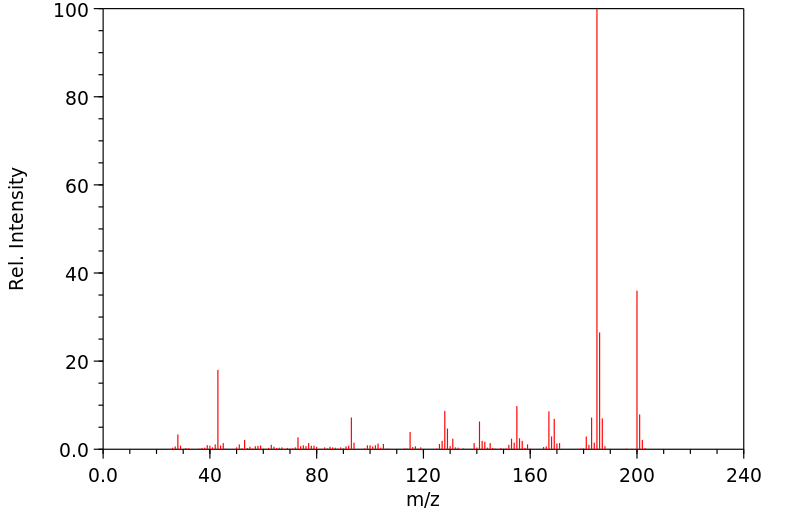1-naphthyltrimethylsilane | 18052-80-7
中文名称
——
中文别名
——
英文名称
1-naphthyltrimethylsilane
英文别名
trimethyl(naphthalen-1-yl)silane;1-trimethylsilylnaphthalene;Silane, trimethyl-1-naphthalenyl-
CAS
18052-80-7
化学式
C13H16Si
mdl
——
分子量
200.356
InChiKey
KIXIRVPOOYJMDA-UHFFFAOYSA-N
BEILSTEIN
——
EINECS
——
-
物化性质
-
计算性质
-
ADMET
-
安全信息
-
SDS
-
制备方法与用途
-
上下游信息
-
文献信息
-
表征谱图
-
同类化合物
-
相关功能分类
-
相关结构分类
物化性质
-
熔点:21.5 °C
-
沸点:99 °C(Press: 0.2 Torr)
-
密度:0.9870 g/cm3
计算性质
-
辛醇/水分配系数(LogP):3.39
-
重原子数:14
-
可旋转键数:1
-
环数:2.0
-
sp3杂化的碳原子比例:0.23
-
拓扑面积:0
-
氢给体数:0
-
氢受体数:0
SDS
上下游信息
-
上游原料
中文名称 英文名称 CAS号 化学式 分子量 —— (1-naphthyl)chlorodimethylsilne 17950-84-4 C12H13ClSi 220.774
反应信息
-
作为反应物:描述:参考文献:名称:氨基甲酸酯与甲硅烷基镁试剂的镍催化交叉偶联反应摘要:与碳-卤素键相比,C O键在交叉偶联反应中具有动力学惰性。因此,开发用于交叉偶联反应中CO键活化的方法学仍然是主要挑战。我们公开了前所未有的镍介导的氨基甲酸酯与甲硅烷基镁试剂的镍介导的交叉偶联,不需要昂贵的甲硅烷基硼烷。甲硅烷基镁试剂是由甲硅烷基锂或甲硅烷基碘制备的。该方法的特征在于三甲基甲硅烷基偶联产物的合成及其合成应用。动力学研究和自由基钟实验揭示了限速C O键断裂,相对于催化剂的半数级和非自由基过渡态。DOI:10.1016/j.jcat.2019.07.026
-
作为产物:参考文献:名称:使用锂从N-芳基吡咯生成芳基锂试剂摘要:在0°C于四氢呋喃中用锂粉处理1-芳基-2,5-二苯基吡咯,可通过还原性CN键断裂产生相应的芳基锂试剂。DOI:10.1055/a-1482-2567
文献信息
-
Selective Transformation of Strychnine and 1,2-Disubstituted Benzenes by C–H Borylation作者:Yutaro Saito、Kotono Yamanoue、Yasutomo Segawa、Kenichiro ItamiDOI:10.1016/j.chempr.2020.02.004日期:2020.4as natural products, pharmaceuticals, and π-conjugated systems are at the heart of constructing and modifying organic molecules, whereby the selectivity and predictability are of the utmost importance. Herein, we report the highly C3-selective C–H borylation of strychnine along with olefin isomerization, catalyzed by an iridium complex with a diphosphine ligand. This method enabled us to rapidly produce
-
Gold-Catalysed Oxyarylation of Styrenes and Mono- and<i>gem</i>-Disubstituted Olefins Facilitated by an Iodine(III) Oxidant作者:Liam T. Ball、Guy C. Lloyd-Jones、Christopher A. RussellDOI:10.1002/chem.201103061日期:2012.3.51‐Hydroxy‐1,2‐benziodoxol‐3(1H)‐one (IBA) is an efficient terminal oxidant for gold‐catalysed, three‐component oxyarylation reactions. The use of this iodine(III) reagent expands the scope of oxyarylation to include styrenes and gem‐disubstituted olefins, substrates that are incompatible with the previously reported Selectfluor‐based methodology. Diverse arylsilane coupling partners can be employed
-
Addition and Cyclization Reactions in the Thermal Conversion of Hydrocarbons with an Enyne Structure, 5. High-Temperature Ring Closures of 1,3-Hexadien-5-ynes to Naphthalenes – Competing Reactions via Isoaromatics, Alkenylidene Carbenes, and Vinyl-type Radicals作者:Jörg Hofmann、Kathrin Schulz、Annett Altmann、Matthias Findeisen、Gerhard ZimmermannDOI:10.1002/jlac.199719971218日期:1997.122-ethynylstyrenes 7a–c were subjected to high-temperature pyrolysis. The cycloisomerization products isolated suggest that these are formed by three competing processes: by (i) an electrocyclic or a molecule-induced, (ii) an alkenylidene carbene controlled, and (iii) a radical-controlled ring-closure process. To estimate the relative importance of these three reactions here mentioned, the substrates have
-
Cobalt-Catalyzed Defluorosilylation of Aryl Fluorides via Grignard Reagent Formation作者:Soobin Lim、Hyungdo Cho、Jongheon Jeong、Minjae Jang、Hyunseok Kim、Seung Hwan Cho、Eunsung LeeDOI:10.1021/acs.orglett.0c02752日期:2020.9.18cheap electrophilic silicon source with magnesium. This method is compatible with various silicon sources and can be operated under aerobic conditions. Mechanistic studies support the in situ formation of a Grignard reagent, which is captured by the electrophilic silicon source.
-
Lewis Acid-Mediated Carboxylation of Aryl- and Allylsilanes with Carbon Dioxide作者:Tetsutaro Hattori、Yutaka Suzuki、Sotaro MiyanoDOI:10.1246/cl.2003.454日期:2003.5Aryl- and allylsilanes are carboxylated with CO2 with the aid of aluminum-based Lewis acids, to give aromatic and β,γ-unsaturated carboxylic acids in fair to good yields, respectively. Formation of the former is rationalized by an aromatic electrophilic substitution by CO2 activated by the Lewis acid, while the latter a nucleophilic addition of in situ-generated allylaluminum species to CO2.
表征谱图
-
氢谱1HNMR
-
质谱MS
-
碳谱13CNMR
-
红外IR
-
拉曼Raman
-
峰位数据
-
峰位匹配
-
表征信息
同类化合物
(S)-溴烯醇内酯
(R)-3,3''-双([[1,1''-联苯]-4-基)-[1,1''-联萘]-2,2''-二醇
(3S,3aR)-2-(3-氯-4-氰基苯基)-3-环戊基-3,3a,4,5-四氢-2H-苯并[g]吲唑-7-羧酸
(3R,3’’R,4S,4’’S,11bS,11’’bS)-(+)-4,4’’-二叔丁基-4,4’’,5,5’’-四氢-3,3’’-联-3H-二萘酚[2,1-c:1’’,2’’-e]膦(S)-BINAPINE
(11bS)-2,6-双(3,5-二甲基苯基)-4-羟基-4-氧化物-萘并[2,1-d:1'',2''-f][1,3,2]二氧磷
(11bS)-2,6-双(3,5-二氯苯基)-4羟基-4-氧-二萘并[2,1-d:1'',2''-f][1,3,2]二氧磷杂七环
(11bR)-2,6-双[3,5-双(1,1-二甲基乙基)苯基]-4-羟基-4-氧化物-二萘并[2,1-d:1'',2''-f][1,3,2]二氧杂磷平
黄胺酸
马兜铃对酮
马休黄钠盐一水合物
马休黄
食品黄6号
食品红40铝盐色淀
飞龙掌血香豆醌
颜料黄101
颜料红70
颜料红63
颜料红53:3
颜料红5
颜料红48单钠盐
颜料红48:2
颜料红4
颜料红261
颜料红258
颜料红220
颜料红22
颜料红214
颜料红2
颜料红19
颜料红185
颜料红184
颜料红170
颜料红148
颜料红147
颜料红146
颜料红119
颜料红114
颜料红 9
颜料红 21
颜料橙7
颜料橙46
颜料橙38
颜料橙3
颜料橙22
颜料橙2
颜料橙17
颜料橙 5
颜料棕1
顺式-阿托伐醌-d5
雄甾烷-3,17-二酮








